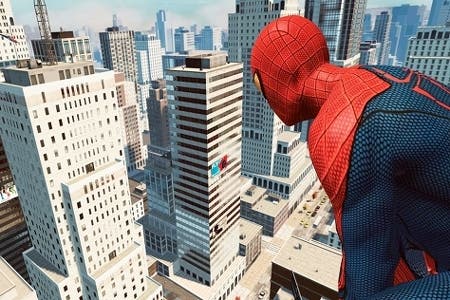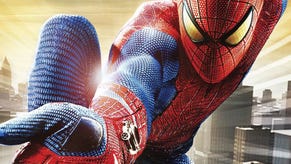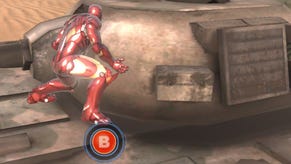The Amazing Spider-Man Review
Aim high, swing low.
In the olden days, superheroes posed a problem for games developers. Hugely popular with The Kids and indulging the very same power fantasies that games tap into, those superhuman abilities were both an alluring proposition and an impossible challenge. Spider-Man had it worst of all. In digital worlds where left, right and jump represented the limits of interaction, a character who could swing from the ceiling and crawl on any surface was beyond the rudimentary physics available at the time.
So after slogging and slugging his way through a series of scrolling 16-bit beat-'em-ups, his true potential untapped, it took Tony Hawk developer Neversoft and the throbbing power of the PlayStation to bring the wall-crawler to life. The 2000 Spidey game may not have been truly open-world - and it may have found our hero swinging from webs attached to nothing above a city sheathed in perpetual fog - but it gave us our first taste of what a real Spider-Man game could be like. As consoles got more powerful, so Spidey could finally take to the concrete canyons of New York, just like he did in the comics.
The trouble is, once you hit on the perfect way to realise a superhero in a game, it becomes hard to deviate from that formula. Since Spider-Man had set up shop at Activision, never a publisher to shy away from a spot of milking, the simple thrill of swinging from Harlem to Battery Park soon became a chore. Review scores drooped and even the man responsible for signing off on the damn things was unimpressed. "Our Spider-Man games have sucked for the last five years," belched Bobby Kotick in 2010, presumably fresh from a seminar on staff motivation.
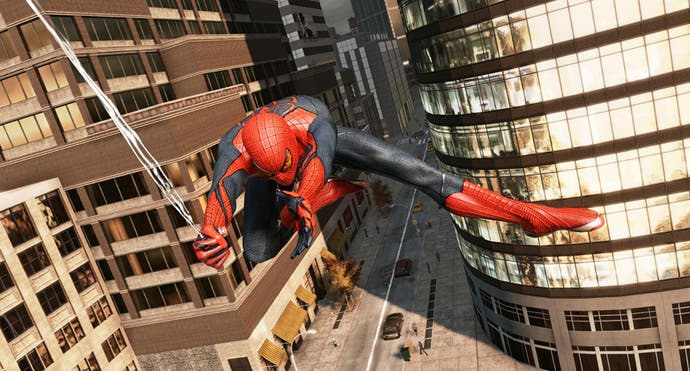
After breaking from that tradition for the surprisingly good Spider-Man: Shattered Dimensions and the less interesting Spider-Man: Edge of Time, current Spidey developer Beenox returns the web-slinger to the open-world genre with this movie tie-in. The result handily illustrates all that is good - and bad - about the well-worn template.
The fundamental appeal of free-roaming web-swinging remains undimmed, augmented here with the best graphics to grace a Spidey title. The adrenalin rush of plummeting to the street before whipping yourself back up to skyscraper level is genuinely thrilling. In a glittering Manhattan that segues from golden-hour sunsets to moonlit night to terracotta sunrises, the decision to move the camera closer to the spandex-clad hero makes simply moving through the game world a cinematic joy.
Adding to this is Web Rush, the most eye-catching new addition to the game. Web Rush neatly solves the most persistent problem with web swinging: accuracy. In previous games, the actual swinging part worked fine, but landing left the camera whirling. Web Rush allows you to slow time down to a crawl, looking around at your leisure to zero in on whatever you want - be it a convenient perch, a collectible item, mission objective or approaching enemy. Centre it in your viewpoint, release the button and Spidey catapults towards it. It's a fine idea, and one that makes navigation - both in the open world and the more enclosed story mission areas - an absolute doddle.
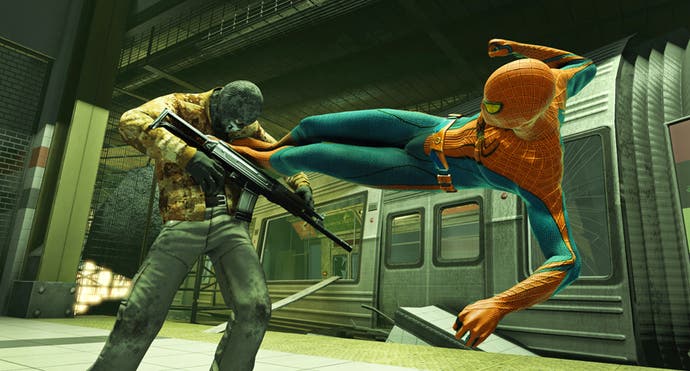
While Web Rush is attached to the right bumper, the left bumper plays host to its opposite - Web Retreat. A tap on this automatically sends Spidey zipping away to the nearest safe spot, essential when the tide of combat turns against you. Between them, these two features resolve many of the issues that previous games have suffered from, but in doing so may leave some players feeling unchallenged. This is an easy game.
Elsewhere, things are more traditional. Beenox drew rather obviously on Rocksteady's Batman games for Shattered Dimensions and that homage recurs here. Combat follows the Caped Crusader's attack/counter/special trifecta, but lacks the pacing and depth. Where Batman's hand-to-hand fighting relied on careful timing, Spidey can get away with much more button-mashing. It's a solid enough foundation but there's not much to master beyond the basics; even as you unlock and upgrade more abilities, it never feels like the game is evolving to match.
There are more echoes of Arkham City when roaming the virtual Manhattan that links the story missions together. Photography assignments find you snapping clues in the environment, but once again there's a lack of depth to the borrowed idea. The objects you need to photograph are always in close proximity and are hardly difficult to spot. Compared to the cryptic conundrums that the Dark Knight had to solve, it's entry-level stuff.
Also filling the game world are the expected diversionary objectives. Some are quick and simple, such as saving citizens from petty thugs on the street, stopping getaway cars or ferrying people to hospital; others require more thought, such as hidden Oscorp labs that play - unsurprisingly - much like Arkham City's Silent Predator challenge rooms. There are also some ridiculously easy checkpoint races and a weird mini-game in which you control a camera following Spidey, trying to keep him in frame for Bruce Campbell's "xtreme" TV show.
"The adrenalin rush of plummeting to the street before whipping yourself back up to skyscraper level is genuinely thrilling."
All quickly become repetitive and the escalation over the course of the 12 hours or so the game takes to clear is minimal. You may have to stop three getaway cars rather than one, but when they all involve the exact same button-mashing quick time event, the sense of occasion falters. Every optional task plays out in exactly the same way, to the point that completing them becomes more of an obligation than something you're doing because it's fun.
There are a couple more in-depth side missions, such as a bank robbery involving Black Cat. But it's often more satisfying simply to swing around the city, seeking out 700 scattered comic book pages and beating up snipers, than it is to concentrate on clearing up the identikit incident icons that pop up after each story chapter.
That story is decent enough, following on from the plot of the new movie (with a pretty major spoiler for those who have yet to see it) and pitting Spidey against rogue Oscorp scientist Alistair Smythe and various mutated enemies caused by the cross-species research of Curt "The Lizard" Connors. This leads to new versions of classic Spidey foes such as Rhino and Scorpion, but reduces them to roaring monsters in the process. It ties everything together neatly but loses a lot of the goofy Silver Age charm of these characters.
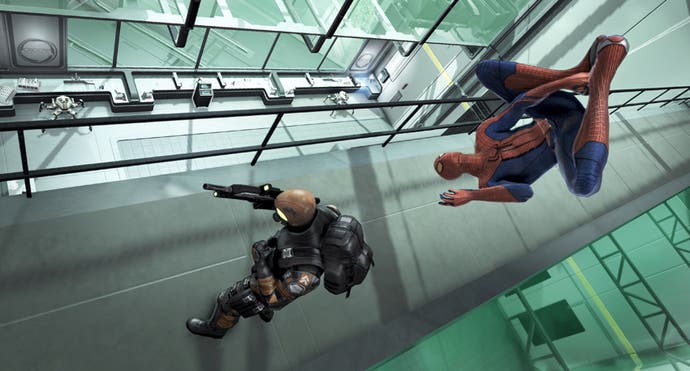
In fact, the story and game world often seem to be at odds with each other. Twitter feed commentary on the loading screens describes New Yorkers panicking as a mutating virus grips the city, while statistics update you on the number of infected rising into the millions, but once you're actually out on the streets everyone is walking and driving around like normal. This disconnect between the fiction and the setting almost leaves it feeling like two different games.
In fact, there's not much here to suggest this needed to be a movie tie-in at all, outside of the marketing demand to have a product on the shelves. None of the movie actors supply the voices, nor are their likenesses used. You don't even see Peter Parker's face throughout the entire game - presumably because revealing that's he not Andrew Garfield would blow the whole point of selling this as the game of the movie.
Despite the disappointments, The Amazing Spider-Man is not a bad game, but it's not the game it could have been. For all the elements borrowed from the Arkham games, the comparison that most often sprang to mind while playing it was the original Assassin's Creed. That, too, had an interesting world and an intuitive, enjoyable method of traversing it. It also had a thin crust of gameplay on top that crumbled the more you poked at it. Repetitive, meaningless tasks, mindless busywork, and the same dialogue on loop every single time - all hinting at something more robust, more ambitious, more finished than what ended up on the disc.
The Amazing Spider-Man takes Marvel's most famous hero and ticks all the boxes required to make him the centre of an enjoyable few days of undemanding play. If Beenox had been allowed the time to build on that foundation - to add more life and colour to Spidey's world, to construct more compelling reasons to explore and develop your abilities - then it could have earned the adjective of its title. The Passable Spider-Man just doesn't have the same ring.
